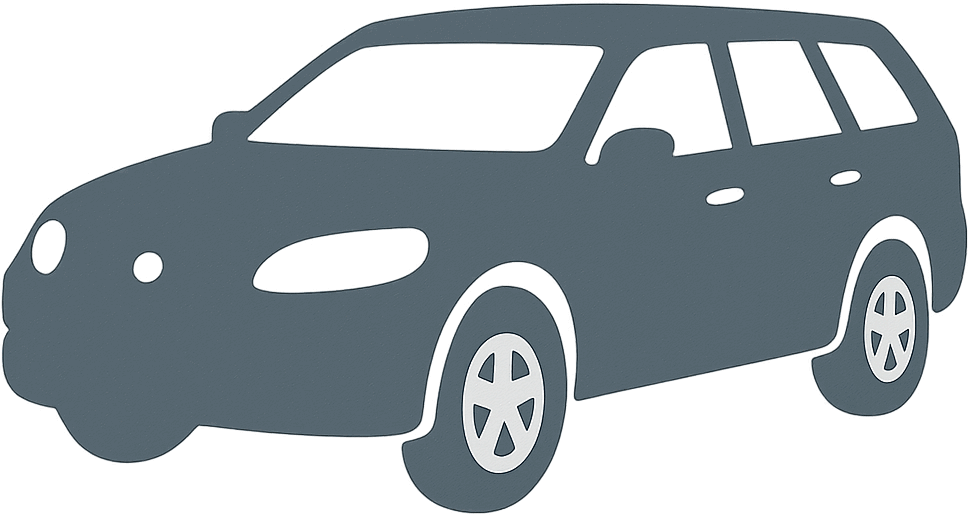 1953 DeSoto Firedome All-Steel Station Wagon (facelift 1953) Dimensions, Size & Specs
1953 DeSoto Firedome All-Steel Station Wagon (facelift 1953) Dimensions, Size & Specs
Measurements of the 1953 DeSoto Firedome All-Steel Station Wagon, engineered for optimal performance and comfort
| Dimensions | |
|---|---|
| Length: | 5404 mm212.8 in17.7 ft |
| Width: | 1963 mm77.3 in6.4 ft |
| Height: | 1588 mm62.5 in5.2 ft |
The 1953 DeSoto Firedome All-Steel Station Wagon is a distinctive classic vehicle produced during the early 1950s, specifically from 1952 to 1953. This model represents the mid-century American station wagon with a robust and spacious design aimed at families and those needing ample cargo space combined with stylish automotive flair. Measuring 5404 millimeters (212.7 inches) in length, the vehicle provides generous interior room compared to many contemporaries, making it well-suited for both passengers and luggage. It spans a width of 1963 millimeters (77.3 inches), giving the Firedome a stable and wide stance on the road, enhancing comfort and safety. Standing at 1588 millimeters (62.5 inches) in height, the all-steel construction adds durability while retaining classic proportions typical of the era. The Firedome All-Steel Station Wagon is noted for its solid build quality, with the facelift for the 1953 model year bringing subtle styling updates that maintained its iconic presence. This car is an excellent example of early 1950s American automotive engineering, blending functional station wagon utility with the DeSoto brand's signature style and performance. For enthusiasts and collectors, the 1953 Firedome station wagon remains a significant piece of automotive history, reflecting the spaciousness and design trends of post-war American family vehicles.
Discover the standout features that make the 1953 DeSoto Firedome All-Steel Station Wagon a leader in its class
Have a question? Please check our knowledgebase first.
The 1953 DeSoto Firedome All-Steel Station Wagon measures 5404 mm (212.7 inches) in length, 1963 mm (77.3 inches) in width, and stands 1588 mm (62.5 inches) tall. These dimensions reflect the typical size for full-size American station wagons of the early 1950s, offering generous interior space for passengers and cargo. With a length exceeding 5.4 meters, this vehicle provides a spacious cabin and cargo area, suitable for family travel or hauling larger loads. The width of just under 2 meters contributes to a stable driving experience while maximizing interior room. Its height, typical of wagons of this era, accommodates ample headroom without making the vehicle overly tall, which assists in garage storage and handling.
Fitting the 1953 DeSoto Firedome All-Steel Station Wagon into a standard residential garage can be challenging due to its size. Standard single-car garages typically have internal dimensions around 6 meters (20 feet) in length and about 3 meters (10 feet) in width. The Firedome wagon's length of 5404 mm (212.7 inches or roughly 17.6 feet) leaves limited clearance in a typical garage, especially when considering space needed for opening doors and maneuvering. The width of 1963 mm (77.3 inches) also takes up much of the available garage width, making it a tight fit. Owners with larger or specially designed garages will find it easier to park this station wagon, but in many standard garages built for smaller or more modern cars, it may be a tight or impractical fit.
Compared to its predecessor (1952 model year), the 1953 DeSoto Firedome All-Steel Station Wagon underwent a facelift that generally retained the platform and dimensions, as DeSoto's station wagons of the early 50s kept a consistent footprint. The earlier 1952 Firedome wagon measured largely similar in length and width, approximately 5400 mm in length and around 1960 mm in width. The 1953 facelift emphasized styling updates rather than changes in size. Therefore, dimensionally the 1953 model is nearly identical or very slightly altered from the 1952 generation, retaining the spaciousness and road presence that defined the Firedome wagon. The model updates focused more on trim, grille design, and updated badges rather than on dimensional changes.
In the context of the early 1950s American station wagons, the 1953 DeSoto Firedome All-Steel Station Wagon was very much competitive in size among full-size wagons from brands like Chevrolet, Ford, and Plymouth. Most full-size wagons of this era measured in the range of 5.2 to 5.5 meters (17 to 18 feet) in length and roughly 1.9 to 2 meters (75 to 78 inches) in width. With its 5404 mm (212.7 inches) length and 1963 mm (77.3 inches) width, the DeSoto fit well within these dimensions, offering ample interior space. Some wagons from luxury brands and higher trims might have been slightly larger, but the Firedome’s dimensions positioned it as a spacious but manageable full-size wagon, blending functionality with stylish design that helped it stand apart in a competitive market.
The 1953 DeSoto Firedome All-Steel Station Wagon stands approximately 1588 mm (62.5 inches) tall. This height is typical for a full-size station wagon of this era, providing generous headroom for passengers and a commanding road presence. While detailed ground clearance figures are not commonly specified for this model, vehicles of this type and period usually offered a ground clearance in the range of 140 to 180 mm (5.5 to 7 inches). This clearance was sufficient for the urban and suburban road conditions of the time, ensuring an adequate balance between ride comfort and passability over rough or uneven surfaces, while supporting the vehicle's family transport and cargo hauling roles.
The 1953 DeSoto Firedome station wagon was designed with family and utility in mind. Its substantial exterior dimensions translate to a roomy interior cabin capable of comfortably seating six or more passengers, typically with two front bucket or bench seats and a spacious rear bench seat. Additionally, as an all-steel station wagon, it offered a large cargo area accessible through the rear liftgate, perfect for groceries, luggage, or equipment. The high roofline (1588 mm or 62.5 inches tall) afforded generous headroom, making it comfortable for adults. The design balanced passenger comfort with practical cargo-carrying ability, defining it well as a true family wagon of the early 1950s.
Specific curb weight data for the 1953 DeSoto Firedome All-Steel Station Wagon is not widely documented but can be estimated based on similar vehicles of the era. Full-size wagons from the early 1950s, constructed mostly with heavy all-steel bodies, generally weighed between 1700 to 2000 kg (3750 to 4400 lbs). The Firedome’s all-steel construction likely places it towards the upper end of this range, reflecting its solid build quality and extensive use of steel in the body structure. The weight influenced ride quality, fuel consumption, and handling characteristics but contributed to the vehicle's durability and road stability.
The 1953 DeSoto Firedome All-Steel Station Wagon's dimensions—5404 mm long, 1963 mm wide, and 1588 mm tall—exemplify the post-war American automotive trends prioritizing spaciousness, comfort, and sturdy construction. Automakers in the early 1950s were moving from wood-bodied wagons to all-steel stations to improve safety, durability, and ease of maintenance. The Firedome’s full-size dimensions reflected the era’s emphasis on passenger comfort and cargo capacity, designed to meet growing suburban family needs. Its slightly larger width improved interior space and road stability, while the moderate height balanced cabin headroom with aerodynamics and garage practicality.
The 1953 DeSoto Firedome All-Steel Station Wagon facelift featured styling updates that distinguish it from its 1952 predecessor while retaining its overall shape. These changes typically included a redesigned front grille, new bumper styles, updated badging, and revised tail light assemblies. The facelift gave the wagon a fresher, more modern appearance aligned with mid-50s styling trends, such as more chrome detailing and smoother body lines. While dimensionally very similar to the 1952 model, these visual upgrades enhanced appeal, aligning the wagon with contemporary tastes and keeping the DeSoto brand competitive in a crowded market.
Compared to modern station wagons, the 1953 DeSoto Firedome All-Steel Station Wagon differs significantly in technology, comfort, and performance despite its imposing size and sturdy build. Its large, heavy steel body and sizable dimensions mean it exhibits less agility and heavier steering than today's vehicles. Modern cars benefit from advanced suspension, power steering, fuel efficiency, and safety features that the 1953 Firedome lacks. However, for its time, the Firedome provided a smooth ride with ample interior space, making it a practical family vehicle. Drivers should be prepared for less responsive handling, slower acceleration, and generally older technology when compared to modern counterparts.
Discover similar sized cars.

| Production: | 1952-1953 |
|---|---|
| Model Year: | 1953 |
| Length: | 5404 mm212.8 in |
| Width: | 1963 mm77.3 in |
| Height: | 1588 mm62.5 in |
